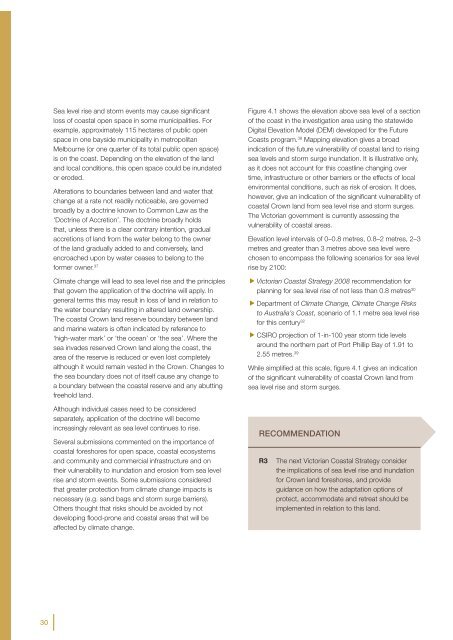Metropolitan Melbourne Investigation - Victorian Environmental ...
Metropolitan Melbourne Investigation - Victorian Environmental ...
Metropolitan Melbourne Investigation - Victorian Environmental ...
You also want an ePaper? Increase the reach of your titles
YUMPU automatically turns print PDFs into web optimized ePapers that Google loves.
Sea level rise and storm events may cause significant<br />
loss of coastal open space in some municipalities. For<br />
example, approximately 115 hectares of public open<br />
space in one bayside municipality in metropolitan<br />
<strong>Melbourne</strong> (or one quarter of its total public open space)<br />
is on the coast. Depending on the elevation of the land<br />
and local conditions, this open space could be inundated<br />
or eroded.<br />
Alterations to boundaries between land and water that<br />
change at a rate not readily noticeable, are governed<br />
broadly by a doctrine known to Common Law as the<br />
‘Doctrine of Accretion’. The doctrine broadly holds<br />
that, unless there is a clear contrary intention, gradual<br />
accretions of land from the water belong to the owner<br />
of the land gradually added to and conversely, land<br />
encroached upon by water ceases to belong to the<br />
former owner. 37<br />
Climate change will lead to sea level rise and the principles<br />
that govern the application of the doctrine will apply. In<br />
general terms this may result in loss of land in relation to<br />
the water boundary resulting in altered land ownership.<br />
The coastal Crown land reserve boundary between land<br />
and marine waters is often indicated by reference to<br />
‘high-water mark’ or ‘the ocean’ or ‘the sea’. Where the<br />
sea invades reserved Crown land along the coast, the<br />
area of the reserve is reduced or even lost completely<br />
although it would remain vested in the Crown. Changes to<br />
the sea boundary does not of itself cause any change to<br />
a boundary between the coastal reserve and any abutting<br />
freehold land.<br />
Although individual cases need to be considered<br />
separately, application of the doctrine will become<br />
increasingly relevant as sea level continues to rise.<br />
Several submissions commented on the importance of<br />
coastal foreshores for open space, coastal ecosystems<br />
and community and commercial infrastructure and on<br />
their vulnerability to inundation and erosion from sea level<br />
rise and storm events. Some submissions considered<br />
that greater protection from climate change impacts is<br />
necessary (e.g. sand bags and storm surge barriers).<br />
Others thought that risks should be avoided by not<br />
developing flood-prone and coastal areas that will be<br />
affected by climate change.<br />
Figure 4.1 shows the elevation above sea level of a section<br />
of the coast in the investigation area using the statewide<br />
Digital Elevation Model (DEM) developed for the Future<br />
Coasts program. 38 Mapping elevation gives a broad<br />
indication of the future vulnerability of coastal land to rising<br />
sea levels and storm surge inundation. It is illustrative only,<br />
as it does not account for this coastline changing over<br />
time, infrastructure or other barriers or the effects of local<br />
environmental conditions, such as risk of erosion. It does,<br />
however, give an indication of the significant vulnerability of<br />
coastal Crown land from sea level rise and storm surges.<br />
The <strong>Victorian</strong> government is currently assessing the<br />
vulnerability of coastal areas.<br />
Elevation level intervals of 0–0.8 metres, 0.8–2 metres, 2–3<br />
metres and greater than 3 metres above sea level were<br />
chosen to encompass the following scenarios for sea level<br />
rise by 2100:<br />
G <strong>Victorian</strong> Coastal Strategy 2008 recommendation for<br />
planning for sea level rise of not less than 0.8 metres 30<br />
G Department of Climate Change, Climate Change Risks<br />
to Australia’s Coast, scenario of 1.1 metre sea level rise<br />
for this century 32<br />
G CSIRO projection of 1-in-100 year storm tide levels<br />
around the northern part of Port Phillip Bay of 1.91 to<br />
2.55 metres. 39<br />
While simplified at this scale, figure 4.1 gives an indication<br />
of the significant vulnerability of coastal Crown land from<br />
sea level rise and storm surges.<br />
RECOMMENDATION<br />
R3<br />
The next <strong>Victorian</strong> Coastal Strategy consider<br />
the implications of sea level rise and inundation<br />
for Crown land foreshores, and provide<br />
guidance on how the adaptation options of<br />
protect, accommodate and retreat should be<br />
implemented in relation to this land.<br />
30
















